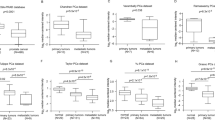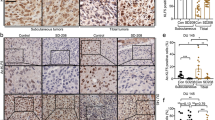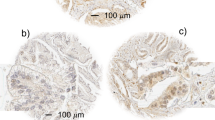Abstract
The osteogenic transcription factor, Runx2, is abnormally expressed in prostate cancer (PCa) and associated with metastatic disease. During bone development, Runx2 is activated by signals known to be hyperactive in PCa including the RAS/MAP kinase pathway, which phosphorylates Runx2 on multiple serine residues including S301 and S319 (equivalent to S294 and S312 in human Runx2). This study examines the role of these phosphorylation sites in PCa. Runx2 was preferentially expressed in more invasive PCa cell lines (PC3>C4-2B>LNCaP). Furthermore, analysis using a P-S319-Runx2-specific antibody revealed that the ratio of P-S319-Runx2/total Runx2 as well as P-ERK/total ERK was highest in PC3 followed by C4-2B and LNCaP cells. These results were confirmed by immunofluorescence confocal microscopy, which showed a higher percentage of PC3 cells staining positive for P-S319-Runx2 relative to C4-2B and LNCaP cells. Phosphorylated Runx2 had an exclusively nuclear localization. When expressed in prostate cell lines, wild-type Runx2 increased metastasis-associated gene expression, in vitro migratory and invasive activity as well as in vivo growth of tumor cell xenografts. In contrast, S301A/S319A phosphorylation site mutations greatly attenuated these Runx2 responses. Analysis of tissue microarrays from 129 patients revealed strong nuclear staining with the P-S319-Runx2 antibody in primary PCas and metastases. P-S319-Runx2 staining was positively correlated with Gleason score and occurrence of lymph node metastases while little or no Runx2 phosphorylation was seen in normal prostate, benign prostate hyperplasia or prostatitis indicating that Runx2 S319 phosphorylation is closely associated with PCa induction and progression towards an aggressive phenotype. These studies establish the importance of Runx2 phosphorylation in prostate tumor growth and highlight its value as a potential diagnostic marker and therapeutic target.
This is a preview of subscription content, access via your institution
Access options
Subscribe to this journal
Receive 50 print issues and online access
$259.00 per year
only $5.18 per issue
Buy this article
- Purchase on Springer Link
- Instant access to full article PDF
Prices may be subject to local taxes which are calculated during checkout







Similar content being viewed by others
References
Jemal A, Siegel R, Ward E, Hao Y, Xu J, Murray T et al. Cancer statistics, 2008. CA. Cancer J Clin 2008; 58: 71–96.
Logothetis CJ, Lin SH . Osteoblasts in prostate cancer metastasis to bone. Nat Rev Cancer 2005; 5: 21–28.
Pratap J, Lian JB, Javed A, Barnes GL, van Wijnen AJ, Stein JL et al. Regulatory roles of Runx2 in metastatic tumor and cancer cell interactions with bone. Cancer Metastasis Rev 2006; 25: 589–600.
Otto F, Thornell AP, Crompton T, Denzel A, Gilmour KC, Rosewell IR et al. Cbfa1, a candidate gene for cleidocranial dysplasia syndrome, is essential for osteoblast differentiation and bone development. Cell 1997; 89: 765–771.
Chua CW, Chiu YT, Yuen HF, Chan KW, Man K, Wang X et al. Suppression of androgen-independent prostate cancer cell aggressiveness by FTY720: validating Runx2 as a potential antimetastatic drug screening platform. Clin Cancer Res 2009; 15: 4322–4335.
Akech J, Wixted J, Bedard K, Van der Bedard K, Hussain S, Guise T et al. Runx2 association with progression of prostate cancer in patients: mechanisms mediating bone osteolysis and osteoblastic metastatic lesions. Oncogene 2009; 2009: 1–11.
Gupta A, Cao W, Chellaiah MA . Integrin alphavbeta3 and CD44 pathways in metastatic prostate cancer cells support osteoclastogenesis via a Runx2/Smad 5/receptor activator of NF-kappaB ligand signaling axis. Mol Cancer 2012; 11: 66.
Pratap J, Wixted JJ, Gaur T, Zaidi SK, Dobson J, Gokul KD et al. Runx2 transcriptional activation of Indian Hedgehog and a downstream bone metastatic pathway in breast cancer cells. Cancer Res 2008; 68: 7795–7802.
van der Deen M, Akech J, Wang T, FitzGerald TJ, Altieri DC, Languino LR et al. The cancer-related Runx2 protein enhances cell growth and responses to androgen and TGFbeta in prostate cancer cells. J Cell Biochem 2010; 109: 828–837.
Zelzer E, Glotzer DJ, Hartmann C, Thomas D, Fukai N, Soker S et al. Tissue specific regulation of VEGF expression during bone development requires Cbfa1/Runx2. Mech Dev 2001; 106: 97–106.
Stewart M, Mackay N, Hanlon L, Blyth K, Scobie L, Cameron E et al. Insertional mutagenesis reveals progression genes and checkpoints in MYC/Runx2 lymphomas. Cancer Res 2007; 67: 5126–5133.
Blyth K, Cameron ER, Neil JC . The RUNX genes: gain or loss of function in cancer. Nat Rev Cancer 2005; 5: 376–387.
Blyth K, Vaillant F, Jenkins A, McDonald L, Pringle MA, Huser C et al. Runx2 in normal tissues and cancer cells: A developing story. Blood Cells Mol Dis 2010; 45: 117–123.
Cho NY, Choi M, Kim BH, Cho YM, Moon KC, Kang GH . BRAF and KRAS mutations in prostatic adenocarcinoma. Int J Cancer 2006; 119: 1858–1862.
Taylor BS, Schultz N, Hieronymus H, Gopalan A, Xiao Y, Carver BS et al. Integrative genomic profiling of human prostate cancer. Cancer Cell 2010; 18: 11–22.
Gioeli D, Mandell JW, Petroni GR, Frierson HF Jr., Weber MJ . Activation of mitogen-activated protein kinase associated with prostate cancer progression. Cancer Res 1999; 59: 279–284.
Mulholland DJ, Kobayashi N, Ruscetti M, Zhi A, Tran LM, Huang J et al. Pten loss and RAS/MAPK activation cooperate to promote EMT and metastasis initiated from prostate cancer stem/progenitor cells. Cancer Res 2012; 72: 1878–1889.
Jeong JH, Wang Z, Guimaraes AS, Ouyang X, Figueiredo JL, Ding Z et al. BRAF activation initiates but does not maintain invasive prostate adenocarcinoma. PLoS ONE 2008; 3: e3949.
Xin L, Teitell MA, Lawson DA, Kwon A, Mellinghoff IK, Witte ON . Progression of prostate cancer by synergy of AKT with genotropic and nongenotropic actions of the androgen receptor. Proc Natl Acad Sci USA 2006; 103: 7789–7794.
Chang YM, Kung HJ, Evans CP . Nonreceptor tyrosine kinases in prostate cancer. Neoplasia 2007; 9: 90–100.
Ge C, Xiao G, Jiang D, Yang Q, Hatch NE, Roca H et al. Identification and functional characterization of ERK/MAPK phosphorylation sites in the Runx2 transcription factor. J Biol Chem 2009; 284: 32533–32543.
Xiao G, Jiang D, Thomas P, Benson MD, Guan K, Karsenty G et al. MAPK pathways activate and phosphorylate the osteoblast-specific transcription factor, Cbfa1. J Biol Chem 2000; 275: 4453–4459.
Ge C, Xiao G, Jiang D, Franceschi RT . Critical role of the extracellular signal-regulated kinase-MAPK pathway in osteoblast differentiation and skeletal development. J Cell Biol 2007; 176: 709–718.
Greenblatt MB, Shim JH, Zou W, Sitara D, Schweitzer M, Hu D et al. The p38 MAPK pathway is essential for skeletogenesis and bone homeostasis in mice. J Clin Invest 2010; 120: 2457–2473.
Li Y, Ge C, Franceschi RT . Differentiation-dependent association of phosphorylated extracellular signal-regulated kinase with the chromatin of osteoblast-related genes. J Bone Miner Res 2010; 25: 154–163.
Ge C, Yang Q, Zhao G, Yu H, Kirkwood KL, Franceschi RT . Interactions between extracellular signal-regulated kinase 1/2 and p38 MAP kinase pathways in the control of RUNX2 phosphorylation and transcriptional activity. J Bone Miner Res 2012; 27: 538–551.
Li Y, Ge C, Long JP, Begun DL, Rodriguez JA, Goldstein SA et al. Biomechanical stimulation of osteoblast gene expression requires phosphorylation of the RUNX2 transcription factor. J Bone Miner Res 2012; 27: 1263–1274.
Ware JL, Paulson DF, Mickey GH, Webb KS . Spontaneous metastasis of cells of the human prostate carcinoma cell line PC-3 in athymic nude mice. J Urol 1982; 128: 1064–1067.
Thalmann GN, Anezinis PE, Chang SM, Zhau HE, Kim EE, Hopwood VL et al. Androgen-independent cancer progression and bone metastasis in the LNCaP model of human prostate cancer. Cancer Res 1994; 54: 2577–2581.
Wai PY, Kuo PC . Osteopontin: regulation in tumor metastasis. Cancer Metastasis Rev 2008; 27: 103–118.
Sato M, Morii E, Komori T, Kawahata H, Sugimoto M, Terai K et al. Transcriptional regulation of osteopontin gene in vivo by PEBP2alphaA/CBFA1 and ETS1 in the skeletal tissues. Oncogene 1998; 17: 1517–1525.
Zheng CF, Guan KL . Properties of MEKs, the kinases that phosphorylate and activate the extracellular signal-regulated kinases. J Biol Chem 1993; 268: 23933–23939.
Zhang H, Pan Y, Zheng L, Choe C, Lindgren B, Jensen ED et al. FOXO1 inhibits Runx2 transcriptional activity and prostate cancer cell migration and invasion. Cancer Res 2011; 71: 3257–3267.
Bello D, Webber MM, Kleinman HK, Wartinger DD, Rhim JS . Androgen responsive adult human prostatic epithelial cell lines immortalized by human papillomavirus 18. Carcinogenesis 1997; 18: 1215–1223.
Kwon TG, Zhao X, Yang Q, Li Y, Ge C, Zhao G et al. Physical and functional interactions between Runx2 and HIF-1alpha induce vascular endothelial growth factor gene expression. J Cell Biochem 2011; 112: 3582–3593.
Zhao M, Zhao Z, Koh JT, Jin T, Franceschi RT . Combinatorial gene therapy for bone regeneration: cooperative interactions between adenovirus vectors expressing bone morphogenetic proteins 2, 4, and 7. J Cell Biochem 2005; 95: 1–16.
Browne G, Nesbitt H, Ming L, Stein GS, Lian JB, McKeown SR et al. Bicalutamide-induced hypoxia potentiates RUNX2-mediated Bcl-2 expression resulting in apoptosis resistance. Br J Cancer 2012; 107: 1714–1721.
Pockwinse SM, Rajgopal A, Young DW, Mujeeb KA, Nickerson J, Javed A et al. Microtubule-dependent nuclear-cytoplasmic shuttling of Runx2. J Cell Physiol 2006; 206: 354–362 C.
Yun SJ, Yoon HY, Bae SC, Lee OJ, Choi YH, Moon SK et al. Transcriptional repression of RUNX2 is associated with aggressive clinicopathological outcomes, whereas nuclear location of the protein is related to metastasis in prostate cancer. Prostate Cancer Prostatic Dis 2012; 15: 369–373.
Tanaka T, Kurokawa M, Ueki K, Tanaka K, Imai Y, Mitani K et al. The extracellular signal-regulated kinase pathway phosphorylates AML1, an acute myeloid leukemia gene product, and potentially regulates its transactivation ability. Mol Cell Biol 1996; 16: 3967–3979.
Yoshimi M, Goyama S, Kawazu M, Nakagawa M, Ichikawa M, Imai Y et al. Multiple phosphorylation sites are important for RUNX1 activity in early hematopoiesis and T-cell differentiation. Eur J Immunol 2012; 42: 1044–1050.
Goh YM, Cinghu S, Hong ET, Lee YS, Kim JH, Jang JW et al. Src kinase phosphorylates RUNX3 at tyrosine residues and localizes the protein in the cytoplasm. J Biol Chem 2010; 285: 10122–10129.
Kim HR, Oh BC, Choi JK, Bae SC . Pim-1 kinase phosphorylates and stabilizes RUNX3 and alters its subcellular localization. J Cell Biochem 2008; 105: 1048–1058.
Qiao M, Shapiro P, Fosbrink M, Rus H, Kumar R, Passaniti A . Cell cycle-dependent phosphorylation of the RUNX2 transcription factor by cdc2 regulates endothelial cell proliferation. J Biol Chem 2006; 281: 7118–7128.
Kawamura N, Kugimiya F, Oshima Y, Ohba S, Ikeda T, Saito T et al. Akt1 in osteoblasts and osteoclasts controls bone remodeling. PLoS ONE 2007; 2: e1058.
Selvamurugan N, Pulumati MR, Tyson DR, Partridge NC . Parathyroid hormone regulation of the rat collagenase-3 promoter by protein kinase A-dependent transactivation of core binding factor alpha1. J Biol Chem 2000; 275: 5037–5042.
Pande S, Browne G, Padmanabhan S, Zaidi SK, Lian JB, van Wijnen AJ et al. Oncogenic cooperation between PI3K/Akt signaling and transcription factor Runx2 promotes the invasive properties of metastatic breast cancer cells. J Cell Physiol 2013; 228: 1784–1792.
Han B, Mehra R, Lonigro RJ, Wang L, Suleman K, Menon A et al. Fluorescence in situ hybridization study shows association of PTEN deletion with ERG rearrangement during prostate cancer progression. Mod Pathol 2009; 22: 1083–1093.
Wang S, Gao J, Lei Q, Rozengurt N, Pritchard C, Jiao J et al. Prostate-specific deletion of the murine Pten tumor suppressor gene leads to metastatic prostate cancer. Cancer Cell 2003; 4: 209–221.
Aytes A, Mitrofanova A, Kinkade CW, Lefebvre C, Lei M, Phelan V et al. ETV4 promotes metastasis in response to activation of PI3-kinase and Ras signaling in a mouse model of advanced prostate cancer. Proc Natl Acad Sci USA 2013; 110: E3506–E3515.
Lim M, Zhong C, Yang S, Bell AM, Cohen MB, Roy-Burman P . Runx2 regulates survivin expression in prostate cancer cells. Lab Invest 2010; 90: 222–233.
Fatherazi S, Matsa-Dunn D, Foster BL, Rutherford RB, Somerman MJ, Presland RB . Phosphate regulates osteopontin gene transcription. J Dent Res 2009; 88: 39–44.
Thirunavukkarasu K, Mahajan M, McLarren KW, Stifani S, Karsenty G . Two domains unique to osteoblast-specific transcription factor Osf2/Cbfa1 contribute to its transactivation function and its inability to heterodimerize with Cbfbeta. Mol Cell Biol 1998; 18: 4197–4208.
Havens AM, Pedersen EA, Shiozawa Y, Ying C, Jung Y, Sun Y et al. An in vivo mouse model for human prostate cancer metastasis. Neoplasia 2008; 10: 371–380.
Acknowledgements
This work was supported by award number W81XWH-11-1-0317 from the Department of Defense (to RTF), and P01 CA093900 from the National Institutes of Health (EK) and I.R.C.C.S Centro di Riferimento Oncologico Della Basilicata Rionero in Vulture (PB). The pOPN-Luc plasmid was a generous gift from Dr. Martha Somerman (NIDCR).
Author information
Authors and Affiliations
Corresponding author
Ethics declarations
Competing interests
The authors declare no conflict of interest.
Additional information
Supplementary Information accompanies this paper on the Oncogene website
Supplementary information
Rights and permissions
About this article
Cite this article
Ge, C., Zhao, G., Li, Y. et al. Role of Runx2 phosphorylation in prostate cancer and association with metastatic disease. Oncogene 35, 366–376 (2016). https://doi.org/10.1038/onc.2015.91
Received:
Revised:
Accepted:
Published:
Issue Date:
DOI: https://doi.org/10.1038/onc.2015.91
This article is cited by
-
RUNX2 recruits the NuRD(MTA1)/CRL4B complex to promote breast cancer progression and bone metastasis
Cell Death & Differentiation (2022)
-
Biologically informed deep neural network for prostate cancer discovery
Nature (2021)
-
Enhanced osteopontin splicing regulated by RUNX2 is HDAC-dependent and induces invasive phenotypes in NSCLC cells
Cancer Cell International (2019)
-
Characterization of CD44 intracellular domain interaction with RUNX2 in PC3 human prostate cancer cells
Cell Communication and Signaling (2019)
-
Oncogenic and osteolytic functions of histone demethylase NO66 in castration-resistant prostate cancer
Oncogene (2019)



